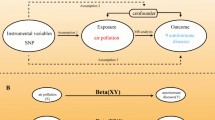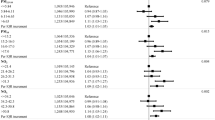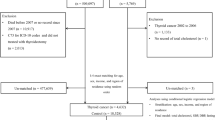Abstract
Thoracic aortic aneurysm and dissection (TAAD) represent a serious health threat, yet the role of air pollution exposure on its development has been underexplored. Here we investigate the relationships between air pollutants and TAAD incidence. In a Cox’s proportional hazards model, hazard ratios (95% confidence intervals) of TAAD for an interquartile range increase in air pollutants were 2.15 (1.96, 2.35) for particulate matter with an aerodynamic diameter ≤2.5 μm (PM2.5; per 2.15 μg m−3 increase), 1.76 (1.61, 1.92) for PM10 (per 2.99 μg m−3 increase), 1.45 (1.34, 1.58) for NO2 (per 6.97 μg m−3 increase) and 1.40 (1.29, 1.51) for NOx (per 11.58 μg m−3 increase). These estimates remained consistent when using inverse probability weighting and generalized propensity score methods. Furthermore, this study revealed potential joint effects and interactions between air pollutants and genetic susceptibility on TAAD risk, especially the multiplicative and additive interactions between PM2.5 and genetic susceptibility. Air pollution exposure is associated with an increased TAAD risk and genetic susceptibility modifies this association.
This is a preview of subscription content, access via your institution
Access options
Subscribe to this journal
Receive 12 digital issues and online access to articles
$119.00 per year
only $9.92 per issue
Buy this article
- Purchase on SpringerLink
- Instant access to full article PDF
Prices may be subject to local taxes which are calculated during checkout



Similar content being viewed by others
Data availability
Data from the UK Biobank are available upon application. The UK Biobank is an open research resource, available after submission of a research plan via the website (https://www.ukbiobank.ac.uk). Air pollution data (2006–2021) were provided by DEFRA (https://uk-air.defra.gov.uk).
Code availability
Codes utilized for analyses have been made available through the GitHub repository at https://github.com/MoooDylan/Ma_TAAD_air-pollution.
References
Carrel, T., Sundt, T. M. 3rd, von Kodolitsch, Y. & Czerny, M. Acute aortic dissection. Lancet 401, 773–788 (2023).
Hiratzka, L. F. et al. 2010 ACCF/AHA/AATS/ACR/ASA/SCA/SCAI/SIR/STS/SVM guidelines for the diagnosis and management of patients with Thoracic Aortic Disease: a report of the American College of Cardiology Foundation/American Heart Association Task Force on Practice Guidelines, American Association for Thoracic Surgery, American College of Radiology, American Stroke Association, Society of Cardiovascular Anesthesiologists, Society for Cardiovascular Angiography and Interventions, Society of Interventional Radiology, Society of Thoracic Surgeons, and Society for Vascular Medicine. Circulation 121, e266–e369 (2010).
Swerdlow, N. J., Wu, W. W. & Schermerhorn, M. L. Open and endovascular management of aortic aneurysms. Circ. Res. 124, 647–661 (2019).
Howard, D. P. et al. Population-based study of incidence and outcome of acute aortic dissection and premorbid risk factor control: 10-year results from the Oxford Vascular Study. Circulation 127, 2031–2037 (2013).
Olsson, C., Thelin, S., Ståhle, E., Ekbom, A. & Granath, F. Thoracic aortic aneurysm and dissection: increasing prevalence and improved outcomes reported in a nationwide population-based study of more than 14,000 cases from 1987 to 2002. Circulation 114, 2611–2618 (2006).
McClure, R. S. et al. Epidemiology and management of thoracic aortic dissections and thoracic aortic aneurysms in Ontario, Canada: a population-based study. J. Thorac. Cardiovasc. Surg. 155, 2254–2264.e2254 (2018).
Martin-Blazquez, A., Heredero, A., Aldamiz-Echevarria, G., Martin-Lorenzo, M. & Alvarez-Llamas, G. Non-syndromic thoracic aortic aneurysm: cellular and molecular insights. J. Pathol. 254, 229–238 (2021).
Erbel, R. et al. 2014 ESC Guidelines on the diagnosis and treatment of aortic diseases: document covering acute and chronic aortic diseases of the thoracic and abdominal aorta of the adult. The Task Force for the Diagnosis and Treatment of Aortic Diseases of the European Society of Cardiology (ESC). Eur. Heart J. 35, 2873–2926 (2014).
Münzel, T., Sørensen, M., Hahad, O., Nieuwenhuijsen, M. & Daiber, A. The contribution of the exposome to the burden of cardiovascular disease. Nat. Rev. Cardiol. 20, 651–669 (2023).
Bhatnagar, A. Cardiovascular effects of particulate air pollution. Annu. Rev. Med. 73, 393–406 (2022).
World Health Organization. WHO Global Air Quality Guidelines: Particulate Matter (PM2.5 and PM10), Ozone, Nitrogen Dioxide, Sulfur Dioxide and Carbon Monoxide (WHO, 2021).
Ming, Y. et al. PM2.5 exposure exacerbates mice thoracic aortic aneurysm and dissection by inducing smooth muscle cell apoptosis via the MAPK pathway. Chemosphere 313, 137500 (2023).
He, X. N. et al. Impact of meteorological conditions and PM2.5 on the onset of acute aortic dissection in monsoonal climate. J. Geriatr. Cardiol. 15, 315–320 (2018).
Wei, Y. et al. Exposure-response associations between chronic exposure to fine particulate matter and risks of hospital admission for major cardiovascular diseases: population based cohort study. Br. Med. J. 384, e076939 (2024).
Pinard, A., Jones, G. T. & Milewicz, D. M. Genetics of thoracic and abdominal aortic diseases. Circ. Res. 124, 588–606 (2019).
Klarin, D. et al. Genome-wide association study of thoracic aortic aneurysm and dissection in the Million Veteran Program. Nat. Genet. 55, 1106–1115 (2023).
Isselbacher, E. M., Lino Cardenas, C. L. & Lindsay, M. E. Hereditary influence in thoracic aortic aneurysm and dissection. Circulation 133, 2516–2528 (2016).
Manolio, T. A. et al. Finding the missing heritability of complex diseases. Nature 461, 747–753 (2009).
Bozzani, A., Sterpetti, A. V., Arici, V., Ragni, F. & Arbustini, E. Air pollution and rupture of abdominal aortic aneurysms. J. Am. Coll. Cardiol. 81, e99 (2023).
Ma, Y. et al. Air pollutants, genetic susceptibility, and abdominal aortic aneurysm risk: a prospective study. Eur. Heart J. 45, 1030–1039 (2024).
Ruddy, J. M., Jones, J. A., Spinale, F. G. & Ikonomidis, J. S. Regional heterogeneity within the aorta: relevance to aneurysm disease. J. Thorac. Cardiovasc. Surg. 136, 1123–1130 (2008).
Isselbacher, E. M. Thoracic and abdominal aortic aneurysms. Circulation 111, 816–828 (2005).
Persson, S. E., Holsti, M., Mani, K. & Wanhainen, A. Difference in risk factor profile for abdominal aortic aneurysm and thoracic aortic aneurysm. J. Vasc. Surg. https://doi.org/10.1016/j.jvs.2024.10.012 (2024).
Gyftopoulos, A., Ziganshin, B. A., Elefteriades, J. A. & Ochoa Chaar, C. I. Comparison of genes associated with thoracic and abdominal aortic aneurysms. Aorta 11, 125–134 (2023).
Jun, X. et al. PM2.5 promotes abdominal aortic aneurysm formation in angiotensin Ⅱ-infused apoe−/− mice. Biomed. Pharmacother. 104, 550–557 (2018).
Hao, H. et al. National cohort study of long-term exposure to PM2.5 components and mortality in Medicare American older adults. Environ. Sci. Technol. 57, 6835–6843 (2023).
Cesaroni, G. et al. Long term exposure to ambient air pollution and incidence of acute coronary events: prospective cohort study and meta-analysis in 11 European cohorts from the ESCAPE Project. Br. Med. J. 348, f7412 (2014).
Wolf, K. et al. Long-term exposure to low-level ambient air pollution and incidence of stroke and coronary heart disease: a pooled analysis of six European cohorts within the ELAPSE project. Lancet. Planet. Health 5, e620–e632 (2021).
Choi, S. W., Mak, T. S. & O’Reilly, P. F. Tutorial: a guide to performing polygenic risk score analyses. Nat. Protoc. 15, 2759–2772 (2020).
Roychowdhury, T. et al. Regulatory variants in TCF7L2 are associated with thoracic aortic aneurysm. Am. J. Hum. Genet. 108, 1578–1589 (2021).
Elbitar, S. et al. Pathogenic variants in THSD4, encoding the ADAMTS-like 6 protein, predispose to inherited thoracic aortic aneurysm. Genet. Med. 23, 111–122 (2021).
Tsutsui, K. et al. ADAMTSL-6 is a novel extracellular matrix protein that binds to fibrillin-1 and promotes fibrillin-1 fibril formation. J. Biol. Chem. 285, 4870–4882 (2010).
Sørensen, M. et al. Long term exposure to road traffic noise and air pollution and risk of infertility in men and women: nationwide Danish cohort study. Br. Med. J. 386, e080664 (2024).
Josey, K. P. et al. Air pollution and mortality at the intersection of race and social class. N. Engl. J. Med. 388, 1396–1404 (2023).
Di, Q. et al. Air pollution and mortality in the Medicare population. N. Engl. J. Med. 376, 2513–2522 (2017).
Elefteriades, J. A. & Farkas, E. A. Thoracic aortic aneurysm clinically pertinent controversies and uncertainties. J. Am. Coll. Cardiol. 55, 841–857 (2010).
Glotzbach, J. P. et al. Familial associations of prevalence and cause-specific mortality for thoracic aortic disease and bicuspid aortic valve in a large-population database. Circulation 148, 637–647 (2023).
Goldfinger, J. Z. et al. Thoracic aortic aneurysm and dissection. J. Am. Coll. Cardiol. 64, 1725–1739 (2014).
Goodney, P. P. et al. Survival after open versus endovascular thoracic aortic aneurysm repair in an observational study of the Medicare population. Circulation 124, 2661–2669 (2011).
Sidloff, D. et al. Mortality from thoracic aortic diseases and associations with cardiovascular risk factors. Circulation 130, 2287–2294 (2014).
Caleyachetty, R. et al. United Kingdom Biobank (UK Biobank): JACC Focus Seminar 6/8. J. Am. Coll. Cardiol. 78, 56–65 (2021).
Sudlow, C. et al. UK Biobank: an open access resource for identifying the causes of a wide range of complex diseases of middle and old age. PLoS Med. 12, e1001779 (2015).
Zheng, G. et al. Effect modification of dietary diversity on the association of air pollution with incidence, complications, and mortality of type 2 diabetes: results from a large prospective cohort study. Sci. Total Environ. 908, 168314 (2024).
Wang, X. et al. Ambient air pollution associated with incident asthma, subsequent cardiovascular disease and death: a trajectory analysis of a national cohort. J. Hazard. Mater. 460, 132372 (2023).
Bycroft, C. et al. The UK Biobank resource with deep phenotyping and genomic data. Nature 562, 203–209 (2018).
Wang, M. et al. Joint exposure to various ambient air pollutants and incident heart failure: a prospective analysis in UK Biobank. Eur. Heart J. 42, 1582–1591 (2021).
von Allmen, R. S., Anjum, A. & Powell, J. T. Incidence of descending aortic pathology and evaluation of the impact of thoracic endovascular aortic repair: a population-based study in England and Wales from 1999 to 2010. Eur. J. Vasc. Endovasc. Surg. 45, 154–159 (2013).
Ma, Y. et al. Differential risk profiles of incident abdominal aortic aneurysms in specific subgroups: a large cohort-based study. Ann. Surg. https://doi.org/10.1097/sla.0000000000006637 (2025).
Vanoli, J. et al. Long-term associations between time-varying exposure to ambient PM 2.5 and mortality: an analysis of the UK Biobank. Epidemiology 36, 1–10 (2025).
Vanoli, J. et al. Association between long-term exposure to low ambient PM2.5 and cardiovascular hospital admissions: a UK Biobank study. Environ. Int. 192, 109011 (2024).
Hanlon, P. et al. Frailty and pre-frailty in middle-aged and older adults and its association with multimorbidity and mortality: a prospective analysis of 493 737 UK Biobank participants. Lancet Public health 3, e323–e332 (2018).
Hang, D. et al. Ultra-processed food consumption and mortality among patients with stages I–III colorectal cancer: a prospective cohort study. eClinicalMedicine 71, 102572 (2024).
Lai, P. S. et al. Gender differences in the effect of occupational endotoxin exposure on impaired lung function and death: the Shanghai Textile Worker Study. Occupat. Environ. Med, 71, 118–125 (2014).
Mansournia, M. A. & Altman, D. G. Inverse probability weighting. Br. Med. J. 352, i189 (2016).
Austin, P. C. Assessing covariate balance when using the generalized propensity score with quantitative or continuous exposures. Statist. Methods Med. Res, 28, 1365–1377 (2019).
Ai, B. et al. Causal association between long-term exposure to air pollution and incident Parkinson’s disease. J. Hazard. Mater. 469, 133944 (2024).
Stafoggia, M. et al. Comparing ‘causal’ and ‘traditional’ approaches in the association of long-term exposure to ambient air pollution on mortality: how sensitive are the results? Environ. Int. 174, 107872 (2023).
Wu, X., Braun, D., Schwartz, J., Kioumourtzoglou, M. A. & Dominici, F. Evaluating the impact of long-term exposure to fine particulate matter on mortality among the elderly. Sci. Adv. 6, eaba5692 (2020).
Harrell, F. E. Regression Modeling Strategies (Springer Verlag, 2015).
Benjamini, Y. & Hochberg, Y. Controlling the false discovery eate: a practical and powerful approach to multiple testing. J. R. Statist. Soc. B 57, 289–300 (1995).
Rutten-Jacobs, L. C. et al. Genetic risk, incident stroke, and the benefits of adhering to a healthy lifestyle: cohort study of 306 473 UK Biobank participants. Br. Med. J. 363, k4168 (2018).
Knol, M. J. et al. Estimating measures of interaction on an additive scale for preventive exposures. Eur. J. Epidemiol. 26, 433–438 (2011).
Assmann, S. F., Hosmer, D. W., Lemeshow, S. & Mundt, K. A. Confidence intervals for measures of interaction. Epidemiology 7, 286–290 (1996).
Agoritsas, T., Merglen, A., Shah, N. D., O’Donnell, M. & Guyatt, G. H. Adjusted analyses in studies addressing therapy and harm: users’ guides to the medical literature. J. Am. Med. Assoc. 317, 748–759 (2017).
Nowell, H. K. et al. Impacts of sugarcane fires on air quality and public health in South Florida. Environ. Health Perspect. 130, 87004 (2022).
Schwartz, J., Bind, M. A. & Koutrakis, P. Estimating causal effects of local air pollution on daily deaths: effect of low levels. Environ. Health Perspect. 125, 23–29 (2017).
Strassmann, A. et al. NO2 and PM2.5 exposures and lung function in Swiss adults: estimated effects of short-term exposures and long-term exposures with and without adjustment for short-term deviations. Environ. Health Perspect. 129, 17009 (2021).
Ma, Y. et al. Air pollution, genetic susceptibility, and the risk of atrial fibrillation: a large prospective cohort study. Proc. Natl Acad. Sci. USA 120, e2302708120 (2023).
Cui, F. et al. Long-term exposure to fine particulate matter constituents, genetic susceptibility, and incident heart failure among 411 807 adults. Eur. J. Heart Failure https://doi.org/10.1002/ejhf.3486 (2024).
Acknowledgements
This work was supported by the National Natural Science Foundation of China (grant no. 824B2102) and the Opening Project of Hubei Key Laboratory of Ischemic Cardiovascular Disease (grant no. SZ202402). We thank all the staff and participants of the UK Biobank and DEFRA for their hard work and dedication in collecting the underlying data.
Author information
Authors and Affiliations
Contributions
Y.H.T. and Y.D.Y.M. contributed to the conception and design of the study, advised on all statistical aspects and interpreted the data. Y.D.Y.M., J.N.W., L.X.T., F.P.C., L.Z., M.Q.X. and Y.H.T. performed the literature search and the analyses. All authors critically reviewed this and previous drafts; all approved the final version of the manuscript; and all approved the final draft for submission, with final responsibility for publication. The corresponding author attests that all the listed authors meet authorship criteria and that no others meeting the criteria have been omitted.
Corresponding author
Ethics declarations
Competing interests
The authors declare no competing interests.
Peer review
Peer review information
Nature Cardiovascular Research thanks Jonathan Newman and the other, anonymous, reviewer(s) for their contribution to the peer review of this work.
Additional information
Publisher’s note Springer Nature remains neutral with regard to jurisdictional claims in published maps and institutional affiliations.
Extended data
Extended Data Fig. 1 Distribution of the GPS for the high and low air pollutants exposure groups.
Abbreviations: GPS, generalized propensity score; PM2.5, particulate matter with diameter <2.5 μm; PM10, particulate matter with diameter <10 μm; NO2, nitrogen dioxide; NOx, nitrogen oxides.
Extended Data Fig. 2 Mean absolute correlation for Cox proportional hazards model and weighted Cox proportional hazards model.
Covariate balance was evaluated using mean AC, with AC < 0.1 indicating good balancing for covariates included in the analyses. Abbreviations: AC, absolute correlation; PM2.5, particulate matter with diameter <2.5 μm; PM10, particulate matter with diameter 10 μm; NO2, nitrogen dioxide; NOx, nitrogen oxides; BMI, body mass index; TDI, Townsend deprivation index.
Extended Data Fig. 3 Associations of long-term PM2.5, PM10, NO2, and NOx exposure with the risk of TAAD in the UK Biobank examined using the Fine-Gray proportional sub-distribution hazards model.
Cumulative incidence curves were plotted using the cumulative incidence function as implemented in the ‘cmprsk’ R package. Abbreviations: PM2.5, particulate matter with diameter <2.5 μm; PM10, particulate matter with diameter <10 μm; NO2, nitrogen dioxide; NOx, nitrogen oxides; TAAD, thoracic aortic aneurysm and dissection.
Extended Data Fig. 4 Associations of PRS with the risk of TAAD in the UK Biobank examined using the Fine-Gray proportional sub-distribution hazards model.
Cumulative incidence curves were plotted using the cumulative incidence function as implemented in the ‘cmprsk’ R package. Abbreviations: PRS, polygenic risk score; TAAD, thoracic aortic aneurysm and dissection.
Supplementary information
Source data
Source Data Fig. 1
Source data for Fig. 1.
Source Data Fig. 2
Source data for Fig. 2.
Source Data Fig. 3
Source data for Fig. 3.
Source Data Extended Data Fig. 1
Source data for Extended Data Fig. 1.
Source Data Extended Data Fig. 2
Source data for Extended Data Fig. 2.
Source Data Extended Data Fig. 3
Source data for Extended Data Fig. 3.
Source Data Extended Data Fig. 4
Source data for Extended Data Fig. 4.
Rights and permissions
Springer Nature or its licensor (e.g. a society or other partner) holds exclusive rights to this article under a publishing agreement with the author(s) or other rightsholder(s); author self-archiving of the accepted manuscript version of this article is solely governed by the terms of such publishing agreement and applicable law.
About this article
Cite this article
Ma, Y., Wang, J., Tang, L. et al. Association of air pollution exposure and genetic susceptibility with increased risk of thoracic aortic aneurysm and dissection. Nat Cardiovasc Res (2025). https://doi.org/10.1038/s44161-025-00719-w
Received:
Accepted:
Published:
DOI: https://doi.org/10.1038/s44161-025-00719-w



